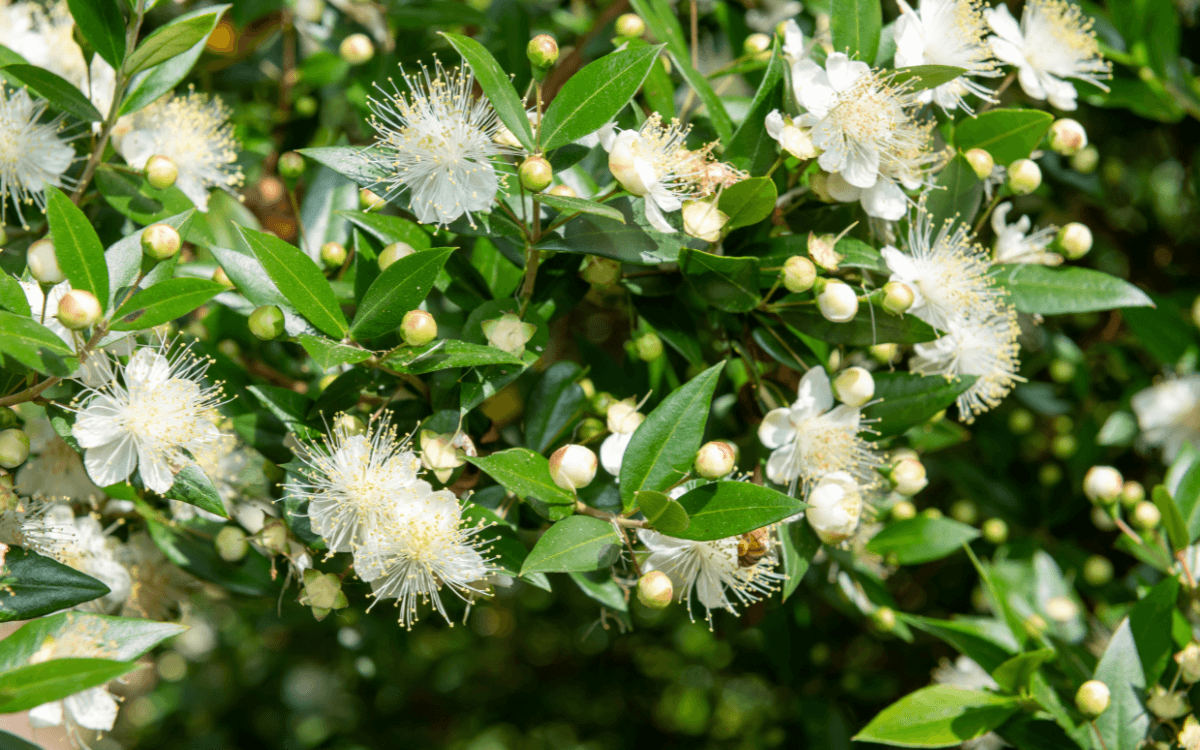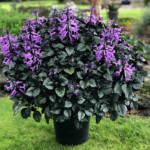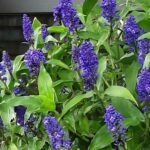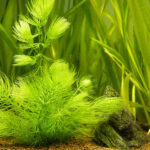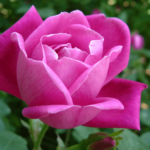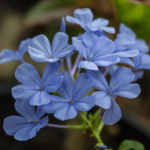The myrtle (Myrtus communis) is a fascinating plant with a rich cultural history and an impressive array of features that make it worthy of our attention.
Originating from Southeast Europe and North Africa, this shrubby or tree-like plant has won hearts over the centuries, from ancient Greek poets to Jewish religious practices.
In this article, we will explore the unique characteristics of myrtle and its importance in different contexts.
Plant Characteristics
The Myrtus communis is known for its graceful stature, reaching over 5 meters (16 feet) in height when grown under ideal conditions.
This plant has thick, dark, fragrant leaves that release a pleasant scent when crushed.
The leaves are large and face each other.
The flowers are white or sometimes pink, with five petals and many filaments in the middle.
The fruits are like small dark berries, full of seeds, which birds love to eat and help disperse.

Moreover, myrtle is resilient, adapting to different environments, especially those with acidic and fresh soils.
It aids in pest control in crops of:
- Citrus
- Olive groves
- Vineyards
- Herbaceous crops
- Dry fruits.
Its versatility also makes it a popular choice for Mediterranean gardens, pots, and residential landscaping.
Plant Uses
The myrtle (Myrtus communis) is a remarkable plant not only for its botanical characteristics but also for its versatility in various uses ranging from medicine to cooking, industry, and even the religious sphere.
Medicine and Health
Attention, the medicinal properties of myrtle mentioned below should be taken as curiosities about the plant only. Visit a doctor before using any medicinal plant.
Myrtle is a valuable source of health benefits.
Its anti-inflammatory, antioxidant, and antiviral properties make it an ally in treating various diseases, such as infections, kidney problems, stomach ulcers, and diabetes.
The leaves and berries of Myrtus communis are rich in ascorbic acid (vitamin C), flavonoids, and essential oil with thymol, among other beneficial substances.
This plant is also known for its antiseptic properties, being effective in preventing and treating oral diseases, refreshing the breath.
Cosmetics and Perfumery
The uses of myrtle extend to the cosmetic industry, where it is a valuable ingredient in creams, cleansing masks, anti-dandruff shampoos, and skin repair tonics.
Its essential oil is a fundamental component in the production of perfumes, soaps, and scented soaps.
Industry
Myrtle wood is used in the production of high-quality charcoal, walking sticks, tool handles, and furniture.
This versatility makes the plant a valuable resource in various industrial applications.
Culinary
In cooking, myrtle offers edible fruits that are often used in the production of marmalades, liqueurs, and even perfumes.
The myrtle liqueur, a typical beverage of Corsica and Sardinia, uses myrtle as its main ingredient.
Furthermore, its leaves, flowers, and fruits are used in cooked dishes, salads, infusions, and alcoholic beverages, adding unique flavors and aromas to Mediterranean cuisine.
Religious and Cultural Practices
Myrtle plays a significant role in religious practices, such as the construction of foliage for the Feast of Tabernacles in Jewish tradition.
It is seen as a symbol of peace and love in many Mediterranean cultures and is cultivated in gardens and groves of these regions.
In summary, the Myrtus communis is a plant that transcends its beauty and appearance, offering a diverse range of uses that make it a valuable presence in our lives, from medicine to cooking, from industry to spirituality.
See below how to cultivate this plant.
How to Care for Myrtle

Myrtle is an easy plant to cultivate, but it requires attention to some important factors for its healthy development.
In this section, we will cover how to properly care for myrtle.
Recommended texts:
- African Iris: How to Care and Propagate
- Sandpaper Vine (Petrea volubilis): Care and Propagation
- China Rose (Rosa chinensis): 8-Step Care Guide
- Spanish Moss: Care, Characteristics and Curiosities
- Ageratum (Floss Flower): Is it Poisonous? Learn to Care
Soil and Light Conditions
Myrtle is a versatile plant when it comes to soil conditions, preferring moist yet well-drained soils.
It can adapt to different types of acidic soils, as long as they are not extremely dry or waterlogged.
Regarding light, myrtle is resilient and can be grown in both shaded areas and under full sun. It is important to protect the plant from cold winds, especially in temperate climate regions.
Irrigation and Humidity
Myrtle does not require large amounts of water, but still needs careful irrigation.
Provide regular watering, especially during the warmer months, but avoid excessive moisture.
In full sun areas, it is advisable to use a watering system to keep the soil consistently moist.
Pruning and Maintenance
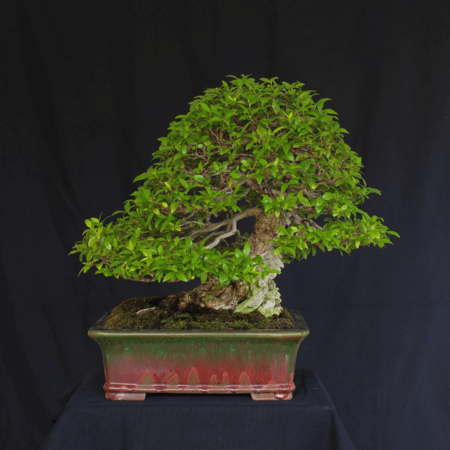
Pruning is an important practice for myrtle care.
It can be done at the end of winter or the beginning of spring, and serves to renew the branches and control the size of the plant.
Moreover, pruning helps improve the appearance of myrtle and stimulates fruit production.
Pests, Diseases, and Other Problems
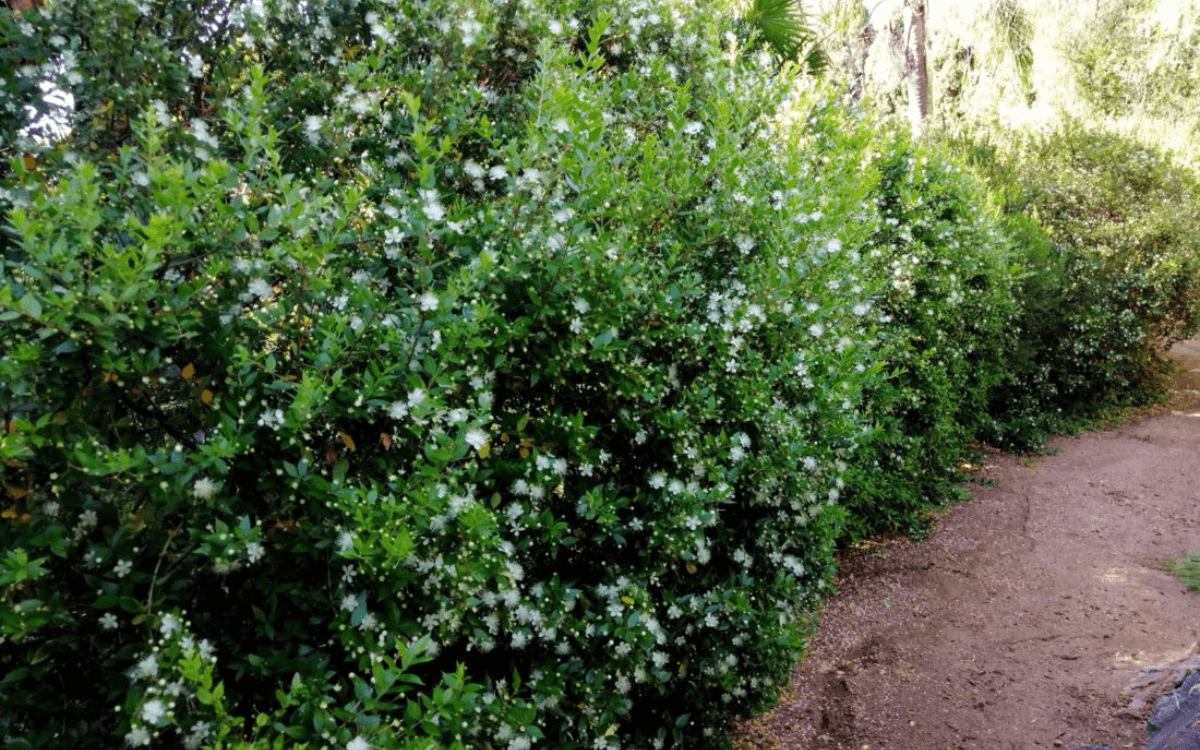
Although Myrtus communis is generally resistant and tolerant to adverse conditions, as previously mentioned, it is important to be aware of possible problems that may affect this charming plant.
Myrtle may occasionally be targeted by pests, including scale insects, thrips, and mites. It is crucial to closely monitor the plant to identify any early infestation.
Effective pest control may include the application of specific treatments, such as mineral oils, if necessary.
Maintaining a healthy and clean environment around the plant can also help reduce the likelihood of infestations.
Regarding diseases, the main issue to watch out for is root rot, which can occur in excessively moist soils. This can weaken the seedling and impair the plant’s development.
To prevent this problem, it is important to ensure that the soil is well-drained and does not retain excessive moisture.
Other Tips for Cultivating and Using Myrtle
In addition to the essential information already shared earlier, there are a number of additional details that can further enrich your knowledge about myrtle:
- Blooms in late spring and during the summer, producing complete flowers with five fragrant petals. The maturation of the fruits occurs in autumn.
- Is often found in xerophytic scrublands and on the edges of woods. Its tolerance to various types of well-drained soils makes it an adaptable plant to different environments.
- Prefers direct light exposure and can even tolerate maritime exposure. It is resistant to temperatures up to -10°C (14°F), making it a suitable choice for regions with moderate winters.
- There are several subspecies and varieties of Myrtus communis, each with distinctive features. This provides a rich genetic diversity for selection and cultivation, allowing you to choose the variety that best suits your needs.
- Myrtle also plays an important role in ecology, contributing to the restoration of disturbed ecosystems and helping control erosion processes.
Now that you have a comprehensive view of myrtle, from its cultivation to its historical and cultural use, you are prepared to fully enjoy all the wonders this plant has to offer.
I hope you enjoyed this article, and if you found any errors or would like to share your story with this plant, leave a comment below.

